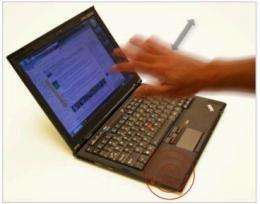May 7, 2012 report
Researchers use Doppler Effect for computer gesture control

(Phys.org) -- Researchers from Microsoft and the University of Washington have together created a system whereby a computer user can use hand gestures to instigate a limited set of computer commands such as scrolling and mimicking mouse double-clicking, that uses nothing but inaudible sound and doesn’t require any hardware other than a standard computer microphone and speakers.
The system is based on the now famous Doppler Effect, whereby the frequency of sound waves changes as an object making noises passes by another that hears it. In the real world, most recognize it as the way sirens appear to change the way they sound when an emergency vehicle passes by. With this new system, the engineers record the change in frequency of a tone (20 and 22 kilohertz, beyond normal hearing range) generated by the computer’s speaker using the computer’s microphone, when an object, such as a hand passes by. Software, the team calls SoundWave analyzes the frequencies and converts them to computer commands. It can also be used with a Smartphone.
Thus far, the team has managed to capture five basic variables involved with the change in frequency: velocity, direction, proximity, the size of the object and time variation. By capturing and measuring these variables when hand gestures are made in front of a computer, SoundWave is able to perform scrolling, recognize tap and double tap (mimic mouse clicks) perform a two handed seesaw (to turn objects on screen) and recognize sustained motion. The result is a system that is good enough to allow a computer user to play a game of Tetris without ever touching the computer. It also can be made to recognize when a person approaches a computer, causing it to wake up, or to go back to sleep as soon as the person leaves.
The team has tested the software on a multitude of different kinds and brands of computers using existing hardware and has found that no tweaking was necessary to perform basic functions and overall commands were executed correctly ninety percent of the time. They also tested the system using a variety of users and in several environments, including a noisy cafeteria and found the software worked reliably in virtually every scenario.
At this point, it appears the team is positioning the SoundWave software as an add-on to computers, serving to fill in some of the gaps in other gesture based systems (such as Microsoft’s Kinect) that rely on cameras and other sensors. They are set to submit a paper for review describing the SoundWave system at the upcoming ACM SIGCHI Conference on Human Factors in Computing.
More information: SoundWave: Using the Doppler Effect to Sense Gestures (research paper)
Project page: research.microsoft.com/en-us/u … roups/cue/soundwave/
© 2012 Phys.Org


















